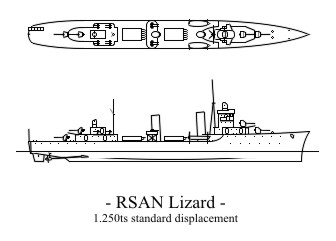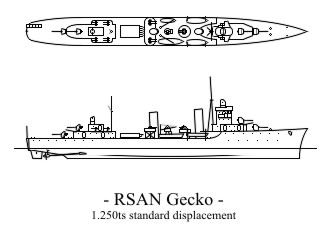[OOC: This should be regarded as OOC-information. Some of the designs have already been released earlier but to give a summary they have been mentioned again.]
The fighting in South America has and will cost the RSAN dearly. Many units sunk or damaged are of the destroyer category. So what´s necessary is an easy to build and simple design allowing mass-production.
RSAN designers envision two variants. One build as an anti-ship weapon to work in the van while the other will be more like a small multi-purpose unit that can also act as a decent escort.
Variant A:

TB35, South African Torpedo Boat laid down 1935
Displacement:
1.211 t light; 1.269 t standard; 1.412 t normal; 1.527 t full load
Dimensions: Length overall / water x beam x draught
336,42 ft / 321,52 ft x 34,45 ft x 11,15 ft (normal load)
102,54 m / 98,00 m x 10,50 m x 3,40 m
Armament:
4 - 5,00" / 127 mm guns in single mounts, 62,50lbs / 28,35kg shells, 1935 Model
Breech loading guns in deck mounts
on centreline ends, evenly spread, 2 raised mounts - superfiring
4 - 1,57" / 40,0 mm guns (2x2 guns), 1,95lbs / 0,88kg shells, 1935 Model
Anti-aircraft guns in deck mounts
on side, evenly spread, all raised mounts
8 - 0,79" / 20,0 mm guns (4x2 guns), 0,24lbs / 0,11kg shells, 1935 Model
Anti-aircraft guns in deck mounts
on side, evenly spread, all raised mounts
Weight of broadside 260 lbs / 118 kg
Shells per gun, main battery: 200
10 - 21,0" / 533 mm above water torpedoes
Armour:
- Gun armour: Face (max) Other gunhouse (avg) Barbette/hoist (max)
Main: 1,38" / 35 mm 0,59" / 15 mm -
2nd: 0,59" / 15 mm - -
3rd: 0,39" / 10 mm - -
Machinery:
Oil fired boilers, steam turbines,
Geared drive, 2 shafts, 37.533 shp / 28.000 Kw = 34,82 kts
Range 4.000nm at 15,00 kts
Bunker at max displacement = 258 tons
Complement:
114 - 149
Cost:
£0,871 million / $3,483 million
Distribution of weights at normal displacement:
Armament: 32 tons, 2,3%
Armour: 14 tons, 1,0%
- Belts: 0 tons, 0,0%
- Torpedo bulkhead: 0 tons, 0,0%
- Armament: 14 tons, 1,0%
- Armour Deck: 0 tons, 0,0%
- Conning Tower: 0 tons, 0,0%
Machinery: 724 tons, 51,3%
Hull, fittings & equipment: 425 tons, 30,1%
Fuel, ammunition & stores: 201 tons, 14,3%
Miscellaneous weights: 15 tons, 1,1%
Overall survivability and seakeeping ability:
Survivability (Non-critical penetrating hits needed to sink ship):
339 lbs / 154 Kg = 5,4 x 5,0 " / 127 mm shells or 0,3 torpedoes
Stability (Unstable if below 1.00): 1,08
Metacentric height 1,2 ft / 0,4 m
Roll period: 13,4 seconds
Steadiness - As gun platform (Average = 50 %): 70 %
- Recoil effect (Restricted arc if above 1.00): 0,27
Seaboat quality (Average = 1.00): 0,80
Hull form characteristics:
Hull has a flush deck
and transom stern
Block coefficient: 0,400
Length to Beam Ratio: 9,33 : 1
'Natural speed' for length: 20,86 kts
Power going to wave formation at top speed: 71 %
Trim (Max stability = 0, Max steadiness = 100): 88
Bow angle (Positive = bow angles forward): 30,00 degrees
Stern overhang: 1,64 ft / 0,50 m
Freeboard (% = measuring location as a percentage of overall length):
- Stem: 22,97 ft / 7,00 m
- Forecastle (30%): 18,70 ft / 5,70 m
- Mid (50%): 10,83 ft / 3,30 m
- Quarterdeck (15%): 10,83 ft / 3,30 m
- Stern: 10,83 ft / 3,30 m
- Average freeboard: 14,49 ft / 4,42 m
Ship space, strength and comments:
Space - Hull below water (magazines/engines, low = better): 184,8%
- Above water (accommodation/working, high = better): 54,9%
Waterplane Area: 7.076 Square feet or 657 Square metres
Displacement factor (Displacement / loading): 58%
Structure weight / hull surface area: 32 lbs/sq ft or 158 Kg/sq metre
Hull strength (Relative):
- Cross-sectional: 0,50
- Longitudinal: 2,10
- Overall: 0,57
Hull space for machinery, storage, compartmentation is cramped
Room for accommodation and workspaces is cramped
Ship has slow, easy roll, a good, steady gun platform
Poor seaboat, wet and uncomfortable, reduced performance in heavy weather
Variant B:

TB35 - MP variant, South African Torpedo Boat laid down 1935
Displacement:
1.210 t light; 1.269 t standard; 1.412 t normal; 1.527 t full load
Dimensions: Length overall / water x beam x draught
336,42 ft / 321,52 ft x 34,45 ft x 11,15 ft (normal load)
102,54 m / 98,00 m x 10,50 m x 3,40 m
Armament:
4 - 5,00" / 127 mm guns in single mounts, 62,50lbs / 28,35kg shells, 1935 Model
Breech loading guns in deck mounts
on centreline ends, evenly spread, 2 raised mounts - superfiring
4 - 1,57" / 40,0 mm guns (2x2 guns), 1,95lbs / 0,88kg shells, 1935 Model
Anti-aircraft guns in deck mounts
on side, evenly spread, all raised mounts
8 - 0,79" / 20,0 mm guns (4x2 guns), 0,24lbs / 0,11kg shells, 1935 Model
Machine guns in deck mounts
on side, evenly spread, all raised mounts
6 - 0,79" / 20,0 mm guns (1x6 guns), 0,24lbs / 0,11kg shells, 1935 Model
Machine guns in deck mount
on centreline amidships, all raised guns - superfiring
Weight of broadside 261 lbs / 118 kg
Shells per gun, main battery: 200
5 - 21,0" / 533 mm above water torpedoes
Armour:
- Gun armour: Face (max) Other gunhouse (avg) Barbette/hoist (max)
Main: 1,38" / 35 mm 0,59" / 15 mm -
2nd: 0,59" / 15 mm - -
3rd: 0,39" / 10 mm - -
4th: 0,39" / 10 mm - -
Machinery:
Oil fired boilers, steam turbines,
Geared drive, 2 shafts, 37.533 shp / 28.000 Kw = 34,82 kts
Range 4.000nm at 15,00 kts
Bunker at max displacement = 258 tons
Complement:
114 - 149
Cost:
£0,872 million / $3,487 million
Distribution of weights at normal displacement:
Armament: 33 tons, 2,3%
Armour: 14 tons, 1,0%
- Belts: 0 tons, 0,0%
- Torpedo bulkhead: 0 tons, 0,0%
- Armament: 14 tons, 1,0%
- Armour Deck: 0 tons, 0,0%
- Conning Tower: 0 tons, 0,0%
Machinery: 725 tons, 51,3%
Hull, fittings & equipment: 428 tons, 30,3%
Fuel, ammunition & stores: 202 tons, 14,3%
Miscellaneous weights: 10 tons, 0,7%
Overall survivability and seakeeping ability:
Survivability (Non-critical penetrating hits needed to sink ship):
356 lbs / 162 Kg = 5,7 x 5,0 " / 127 mm shells or 0,3 torpedoes
Stability (Unstable if below 1.00): 1,17
Metacentric height 1,3 ft / 0,4 m
Roll period: 12,5 seconds
Steadiness - As gun platform (Average = 50 %): 71 %
- Recoil effect (Restricted arc if above 1.00): 0,25
Seaboat quality (Average = 1.00): 0,81
Hull form characteristics:
Hull has a flush deck
and transom stern
Block coefficient: 0,400
Length to Beam Ratio: 9,33 : 1
'Natural speed' for length: 20,86 kts
Power going to wave formation at top speed: 71 %
Trim (Max stability = 0, Max steadiness = 100): 88
Bow angle (Positive = bow angles forward): 30,00 degrees
Stern overhang: 1,64 ft / 0,50 m
Freeboard (% = measuring location as a percentage of overall length):
- Stem: 22,97 ft / 7,00 m
- Forecastle (30%): 18,70 ft / 5,70 m
- Mid (50%): 10,83 ft / 3,30 m
- Quarterdeck (15%): 10,83 ft / 3,30 m
- Stern: 10,83 ft / 3,30 m
- Average freeboard: 14,49 ft / 4,42 m
Ship space, strength and comments:
Space - Hull below water (magazines/engines, low = better): 184,7%
- Above water (accommodation/working, high = better): 99,9%
Waterplane Area: 7.076 Square feet or 657 Square metres
Displacement factor (Displacement / loading): 58%
Structure weight / hull surface area: 33 lbs/sq ft or 160 Kg/sq metre
Hull strength (Relative):
- Cross-sectional: 0,50
- Longitudinal: 2,12
- Overall: 0,58
Hull space for machinery, storage, compartmentation is cramped
Room for accommodation and workspaces is adequate
Ship has slow, easy roll, a good, steady gun platform
Poor seaboat, wet and uncomfortable, reduced performance in heavy weather
Comments welcome....






Quoted
Originally posted by thesmilingassassinQuoted
Originally posted by Kaiser KirkQuoted
Further, I think they are to small. A slightly larger ship with an extra 5" gun would be superior, and could manage more range. Using GoogleEarth, the distance from Buenos Aries to Capetown is about 3,660nm, and to Duoala is about 4,400nm. Which means you have 0 tactical flexibility to deviate from the shortest course if making transit, unless you have oilers in tow.Quoted
I continue to like the light destroyers. I do wonder why the RSAN sees the need for mounts and hoists on the LDs and not the DDs.Quoted
The gunboat is interesting. I should point out that the belt, while 115%, does not fully cover the critical spaces. This is because the engines and fuel take up 118%, which I keep interpreting as protruding above the waterline. If that interpretation is correct, then the armor belt is not high enough. May I suggest 12kts might be suitable?Quoted
To schill for my naval export business : If the RSAN feels that their skills with Sub design are rusty, the Dutch O-5 Zwaardvisch (schnorkel not included) might serve. They were designed after the building of the K-17 and O-1 classes, as well as the building and testing of an experimental submarine.Quoted
Originally posted by Red AdmiralQuoted
It'll probably be better to either;Quoted
The minesweeper is rather heavily armed with that 128mm gun. Any particular reason for it?